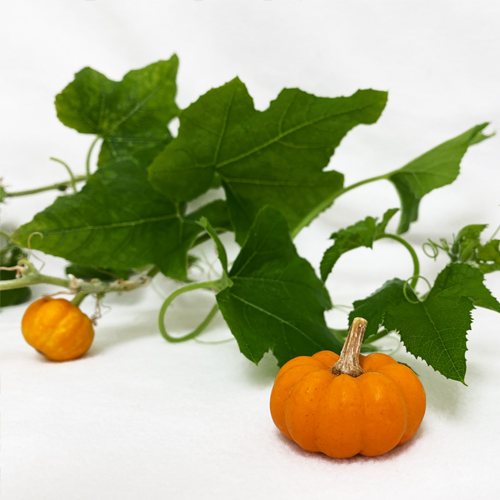Mini Pumpkin
Latin name: Cucurbita pepo
🌱 Days to Sprout: 7-14
😋 Ready for Full Dose of plant food with true leaves or roots .5-inch long
✂️ Thin to: 1 plant per yCube
🍅 Days to Maturity: 100-130
💡 Light Zone: High
📏 Plant Size: 2 ft
💚 Care Level: Advanced
Origin
Pumpkins were first grown in Central America hundreds of years ago. Today, these squashes can be found in many colors of the rainbow and a wide variety of sizes, ranging from handheld miniatures to 1-ton giants.
Qualities
Mini Pumpkins are a vining plant with bright orange fruit that only grow to about 2-3 inches big. While this adorable fall favorite is popular for many ornamental uses, its flesh is also edible with a mild, slightly sweet taste. Mini Pumpkins develop separate “male” and “female” flowers that are both needed for proper pollination and fruit formation (see Care & Harvest for details).
Use
Mini Pumpkins have a multitude of decorative and culinary uses. Enjoy the fruit as a tabletop (or Gardyn lid) accent, as a medium for arts and crafts projects, or baked or roasted into a festive appetizer. You can even carve your Mini Pumpkin as a tiny jack-o-lantern, or turn it into a fun serving bowl for your favorite soup, curry, or custard.
Care & Harvest
🐝 Pollination: Mini Pumpkins require pollination. Pumpkins are monecious meaning they grow both male and female flowers. Male flowers have thin, straight stems and open first, while female flowers have round, swollen stems (like a baby fruit) and open later. Both must be present to make fruit. When flowers appear, hand-pollinate them by alternating between male and female flowers, gently disturbing the inside of blossoms with your finger or a small brush. If the plant is stressed, it will drop its female flowers almost immediately.
TIP: To increase pollination timing success, try growing 2 Mini Pumpkins simultaneously, allowing you to cross-pollinate the plants. You can also try to pick and save a male flower by removing its petals and placing it in a dry, airtight container in the refrigerator for 1-2 days before using it.
Male flower from left to right: unopened, from the side with a straight stem leading up to the flower's base, and looking at the stamen covered in pollen inside the flower's center
Female flower from left to right: unopened, from the side with a round baby fruit shape leading up to the flower's base, and looking at the 4-lobed stigma inside the flower's center
🫶 Support: Mini Pumpkins require support as they mature. Once the plant reaches 6 inches, ensure it’s in its final spot on your Gardyn so you can direct the vine’s growth up the center column. We recommend using our Trellis and Plant Belts to help.
We suggest using our Plant Belt to support the plant and its heavy fruit as it matures.
✂️ Pruning: Mini Pumpkins require pruning. Snip away yellow or brown leaves if they appear, and trim back the main stem if it grows beyond 2 feet. This allows for lateral branches to grow, making the plant bushier while ensuring the vine stays within your Gardyn’s light.
Mini Pumpkins have a robust root system, so we recommend checking the roots twice a month and trimming any that are brown or extending past the yPod.
Once flowers start to fade, remove any that don't have a fruit forming by pinching the stem below the base of the flower head. This helps the plant refocus its energy on producing the next wave of blooms. Foliage may show signs of stress as fruit begin ripening, which is normal.
🔎 Plant Health: Mini Pumpkins require very high nutrient levels to sustain healthy growth. To meet this need, add the Blooming & Fruiting dosage of plant food (1 teaspoon per gallon of water in the tank) and we recommend twice monthly root checks/pruning and weekly doses of HydroBoost. In addition, we recommend only growing 2 Mini Pumpkin yCubes on your Gardyn at a time. Aphids and spider mites are common pests, but you can use our prevention tricks to keep them at bay!
🎃 Harvest: These adorable Mini Pumpkins are ready to harvest when they are about 2-3 inches in diameter, 1-2 inches tall, and have fully developed their bright orange color. When harvesting, use clean scissors to cut the pumpkin from the vine, leaving 1-2 inches of stem intact on the pumpkin. Each plant can produce 2-3 mini pumpkins depending on care.
Our Plant Health & Nutrition Team thoroughly tests each variety we offer to bring you the most flavorful and high-quality plants. We regularly rotate our plant portfolio, so please note, availability varies.



